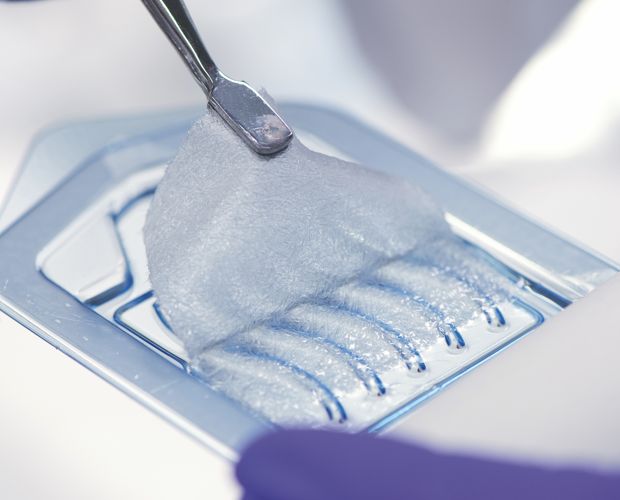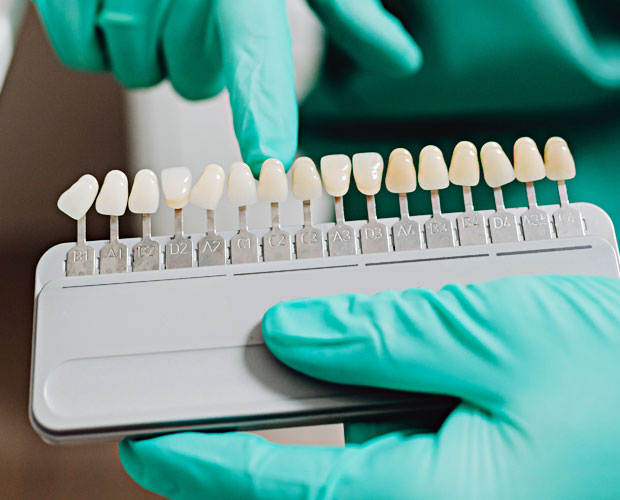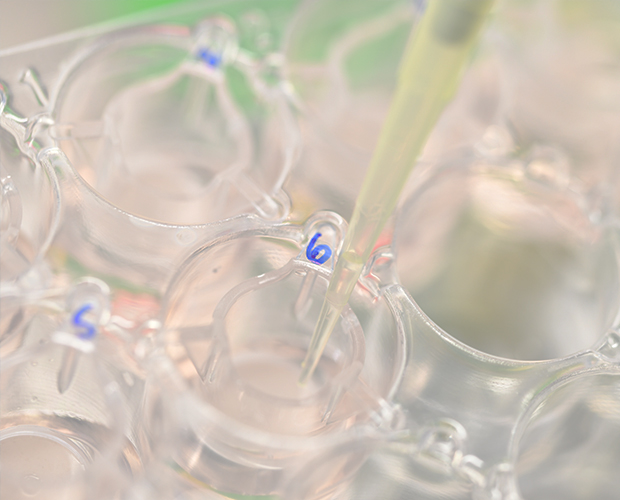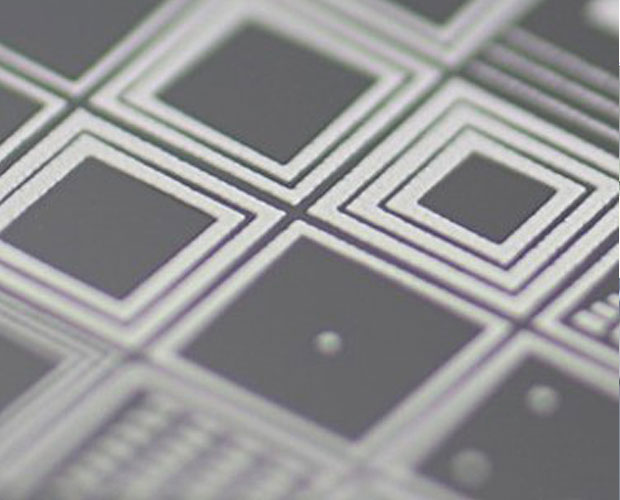Initial research
The Fraunhofer-Gesellschaft promotes pre-competitive research with its internal programs.

In 2014, the United Nations declared the decreasing effectiveness of antibiotics a serious threat to global health. In the EU, approximately 670,000 people become ill each year due to antibiotic-resistant pathogens, which typically enter the body through wounds during medical treatment. In around 5% of cases, these infections can be fatal.
To enable sustainable and efficient therapies, particularly for chronic wounds caused by pressure ulcers, diabetes, circulatory disorders, etc., a disruptive change towards intelligent and individually combinable therapy concepts is required. These concepts should be unaffected by the development of bacterial resilience development.
The aim of the project is to develop innovative medical products for wound healing by combining scientifically recognised antimicrobial peptides (AMPs) from wound maggots (Lucilia sericata) with a patented and market-approved absorbable wound fleece based on silica gel as a carrier material (ISC). To achieve this, processes for the recombinant production of AMPs from the wound maw on a GMP-compliant industrial scale (IME-BR) need to be developed. The wound dressings modified with peptides will undergo evaluation in an established 3D in-vitro wound model (ISC).
The combination of bioactive peptides from insects with commercially approved regenerative wound dressings is a groundbreaking product innovation. This leads to a significant improvement in therapy and more economical wound care.
The development partners will primarily be German and European SMEs that characterise the market for wound care and medical products.
Project lead: Andreas Vilcinskas (IME-BR)

The natural tooth crown is composed of hard enamel on the surface and softer dentine on the inside. This structure not only gives the tooth its natural appearance but also provides complex protection against mechanical damage. Current restorations are monolithic and do not consider the enamel-dentine structure. Monolithic restorations are problematic as implant superstructures due to their lack of damping properties and can lead to implant loss.
The aim of this SME application is to recreate the natural structure of the tooth using biomimicry. The Fraunhofer ISC offers two dental material systems for this purpose: hard lithium silicate glass-ceramics and softer ORMOCER®s, which can replace the enamel and dentine, respectively. Although the intrinsic properties of the respective material pairs can be easily compared, the boundary surface presents a greater challenge. To recreate the dentin-enamel junction (DEJ), it is necessary to develop the boundary surface between the glass-ceramic and ORMOCER® in detail. This includes considering factors such as roughness, pre-treatment, and adhesive application.
The aim is to replicate the natural tooth structure by using glass-ceramic as the enamel and ORMOCER® as the dentine substitute, with a focus on optimising the boundary surface (dentine-enamel junction). The effectiveness of this approach will be demonstrated through fracture mechanics tests on corresponding demonstrators.
Manufacturers of dental materials and implant systems, such as DeguDent GmbH (DentsplySirona), well-known to the ISC, are potential direct customers for the project results to make the systems and semi-finished products available to the dental market. The main sales will be generated by downstream medium-sized dental laboratories and dental practices.
Project lead: Dr. Bernhard Durschang (ISC)
INVITROCT - Development of a non-invasive quality assurance methodology for in-vitro tissue based on OCT
01.2023 - 12.2025

Tissue engineering is being translated into regenerative medicine. The use of laboratory animals for drug and substance screening is decreasing due to restrictive legislation. Therefore, there is an increasing demand for in vitro engineered tissues for implantation and in vitro screening systems. Currently, quality control of in vitro cultivated tissues involves destructive methods. However, these methods are costly, time-consuming, and do not allow for permanent monitoring of structural changes or reliable assessment of the entire tissue.
The INVITROCT project aims to demonstrate the potential of optical coherence tomography (OCT) as a non-invasive and efficient quality monitoring tool for in vitro tissue. The project will identify quality markers in OCT data for various tissue models through systematic analyses and validate their significance through measurements. An analysis tool is to be developed based on these results. The tool will automatically assess the quality of OCT images of in vitro tissue. This tool can be used by numerous end users in the field of tissue engineering and regen. Enabling OCT as a cost-effective and reliable alternative to previous complex testing methods should make it easier for SMEs, in particular, to access the production of advanced therapy medical products (ATMPs) and in vitro models. Additionally, it will enable new analysis methods for contract laboratories. The successful completion of the INVITROCT project would represent an innovative leap forward in the quality assurance of in vitro tissue-based products. From an analogue, invasive, punctual, and time-consuming quality assurance method, we have transitioned to a digital, contactless, non-invasive, and scalable one.
Project lead: Dipl.-Phys. Niels König (IPT)

Green hydrogen plays a crucial role in addressing climate change and the need for CO2-free or CO2-neutral processes. The preferred method for producing green hydrogen is water electrolysis. The efficiency of this method still needs to be optimized, and the criticality of the catalyst materials used creates a supply bottleneck. Currently, platinum, iridium, and ruthenium are the primary catalyst materials used in proton exchange membrane electrolysis (PEM electrolysis). However, the demand for these precious metals already exceeds the supply, and their availability is mainly from countries with challenging political or human rights situations. This issue will become more severe in the future as production capacities expand to meet the projected demand for green hydrogen. Currently, it has not been possible to develop alternative materials with equal or better properties. However, a significant reduction in the amount of catalyst required may also be part of the solution.
This is where the Q-Elec project comes in. By using a new type of material, the amount of critical precious metals required is to be reduced to an extremely low level (from 0.5-1 mg/cm² to less than 10 µg/cm²).
Furthermore, the potential of substituting platinum metals with alternative, non-critical materials while maintaining performance is currently under investigation through the strategic arrangement of metals at the nano level. Throughout the project, aside from "proof of principle" of its suitability as a catalyst material for the production of hydrogen by electrolysis of water, other potential and promising areas of application will be identified. The innovation research institute Fraunhofer INT will be responsible for this task as a cooperation partner of the Fraunhofer ISC.
Project lead: Dr. Marina Gárdonyi (ISC)
UNDERPRESSURE - Self-generating salt hydrate systems for heat storage under osmotic pressure
04.2023 - 03.2024
How can solar energy be stored more efficiently using technical means? This is an almost existential question in times of rising energy prices and falling indoor temperatures during the heating season. Solar thermal collectors can capture the sun's heat radiation, which is available practically everywhere in the world. However, there are strong regional and seasonal fluctuations, and the heat is usually needed at times other than when it is available in abundance. The DISCOVER project, UnderPressure, aims to store solar heat using an unconventional approach, making it easily accessible once again.
The project idea centres around the use of phase change materials, which are capable of absorbing and releasing thermal energy within a specific temperature range by transitioning between solid and liquid states. While this principle is not new, it has yet to gain widespread technical acceptance. There are several reasons for this. Paraffins exhibit this behaviour, but due to their flammability, they can only be used in small quantities or under special safety precautions. Heat can also be stored chemically and physically in certain salt hydrates, which can be released as required and transported. Salt hydrates have the advantage over paraffins as they are non-flammable and relatively inexpensive. However, they are sensitive to moisture and must be protected, for example, by being tightly encapsulated. However, achieving this objective is extremely challenging due to the significant volume change that occurs during the phase transition.
UnderPressure works in the opposite direction. Instead of making the encapsulation as tight as possible and therefore susceptible to faults, a special casing is being developed that allows flexible equalisation. This protects the function of the salt hydrates from moisture in the long term and extends the range of applications, from continuous underwater use to underground tanks in the garden. The materials should possess high thermal shock resistance, good heat transfer, and high energy density, while also being easily scalable for production.
The DISCOVER project aims to demonstrate the feasibility of using an encapsulated salt hydrate in an aqueous environment. The project focuses on three components: capsule content, encapsulation material, and environment. The goal is to create phase change material systems that are easy to handle, transport, and store. This will help to make better use of solar heat and reduce CO2 emissions.
Project lead: Dr. Benedikt Schug (ISC)

Highly sensitive sensors, such as bulk and surface acoustic wave sensors or micromechanical sensors, generally require stable encapsulation for packaging to protect the sensitive functional components. The process technology required for this must be able to compensate for unevenness, such as contact conductor paths and indentations on the substrate materials, while at the same time not affecting the functional sensor components thermally or mechanically. Interlayer-based encapsulation processes are used here, such as eutectic bonding and glass solder bonding. In these processes, the components are subjected to a high joining temperature as part of the respective process chain. Against the background of increasing miniaturisation and integration density, processes with minimal thermal stress are required to protect temperature-sensitive structures and functional sensor materials.
The objective of the project is to create an end-to-end laser-based process chain that eliminates the current oven-based drying and pre-glazing step used for glass soldering. This will be replaced by selective laser irradiation. The use of contactless and spatially resolved inkjet-based solder application will allow for a flexible and selective solder layer structure. This will enable the levelling of trenches and conductor paths in the joining area. The planarisation step, which is typically used, can be omitted, and the process chain can be shortened. Additionally, this approach can gradually equalise the expansion coefficients, reducing internal stresses in the component. The already established laser-based glass solder bonding completes the process chain.
The result of this project is an encapsulation process with a purely laser-based process chain, characterised by a selective, local thermal energy input in combination with a selective, spatially resolved printing technology for solder application. The results of this development work will be used to create a technology demonstrator for commercialisation and exploitation of the project results.
The sensor industry, primarily consisting of medium-sized companies, and its machine suppliers for joining technologies are central to the diffusion of the new technology.
Project lead: Dr. Alexander Olowinsky (ILT)